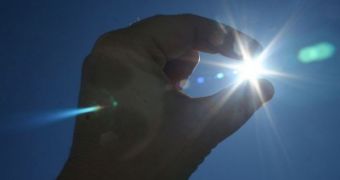A new paper published in today's issue of the journal Science documents the development of a new device that is fairly effective at breaking down water into oxygen and hydrogen, the second of which can be stored as fuel.
Scientists with the University of Stanford, who worked on designing and manufacturing this innovative device, explain that their invention is basically a silicon semiconductor that sports a very thin layer of nickel on its surface.
“Nickel is corrosion-resistant. It's also an active oxygen-producing catalyst, and it's earth-abundant. That makes it very attractive for this type of application,” explains study author Michael J. Kenney.
The device works by absorbing light and using the energy it collects in this manner to make the hydrogen and the oxygen present in water divorce each other. As already mentioned, the latter is stored as fuel and, when energy is needed, allowed to interact with atmospheric oxygen in a fuel cell.
As a result of this interaction, both electricity and water are produced, the Stanford University researchers explain. No greenhouse gases are emitted, so the whole process is as environmentally friendly as it gets.
In their paper, the researchers detail that, when two silicon electrodes coated with a 2-nanometer-thick layer of nickel were placed in a solution of water and potassium borate and exposed to light and electricity, they continuously broke down water into oxygen and hydrogen without showing any signs of being affected by corrosion.
Things took a turn for the better when lithium was added to the mix.
“Remarkably, adding lithium imparted superior stability to the electrodes. They generated hydrogen and oxygen continuously for 80 hours – more than three days – with no sign of surface corrosion,” Michael J. Kenney says.
“These results represent a significant advance over previous experimental efforts. Our lab has produced one of the longest lasting silicon-based photoanodes. The results suggest that an ultrathin nickel coating not only suppresses corrosion but also serves as an electrocatalyst to expedite the otherwise sluggish water-splitting reaction,” adds Professor Hongjie Dai.
The researchers hope that, in the not so distant future, hydrogen-powered fuel cells based on their discovery will be paired with solar cells and used to generate electricity either when there isn't enough light available, or when demand peaks.

 14 DAY TRIAL //
14 DAY TRIAL //